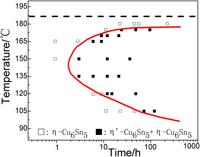Crossref Citations
This article has been cited by the following publications. This list is generated based on data provided by Crossref.
Luo, Zhongbing
Wang, Lai
Fu, Qinqin
Cheng, Chongqian
and
Zhao, Jie
2011.
Formation of interfacial η′-Cu6Sn5 in Sn–0.7Cu/Cu solder joints during isothermal aging – ERRATUM.
Journal of Materials Research,
Vol. 26,
Issue. 14,
p.
1742.
Zeng, Guang
McDonald, Stuart D.
Gu, Qinfen
and
Nogita, Kazuhiro
2012.
Effect of Zn, Au, and In on the polymorphic phase transformation in Cu6Sn5intermetallics.
Journal of Materials Research,
Vol. 27,
Issue. 20,
p.
2609.
Ye, Huan
Xue, Songbai
and
Pecht, Michael
2012.
Evaluation of the microstructure and whisker growth in Sn–Zn–Ga solder with Pr content.
Journal of Materials Research,
Vol. 27,
Issue. 14,
p.
1887.
Nogita, K.
Mu, D.
McDonald, S.D.
Read, J.
and
Wu, Y.Q.
2012.
Effect of Ni on phase stability and thermal expansion of Cu6−xNixSn5 (X = 0, 0.5, 1, 1.5 and 2).
Intermetallics,
Vol. 26,
Issue. ,
p.
78.
Zeng, Guang
McDonald, Stuart D.
Gu, Qinfen
Suenaga, Shoichi
Zhang, Yong
Chen, Jianghua
and
Nogita, Kazuhiro
2013.
Phase stability and thermal expansion behavior of Cu6Sn5 intermetallics doped with Zn, Au and In.
Intermetallics,
Vol. 43,
Issue. ,
p.
85.
Zeng, Guang
McDonald, Stuart D.
Read, Jonathan J.
Gu, Qinfen
and
Nogita, Kazuhiro
2014.
Kinetics of the polymorphic phase transformation of Cu6Sn5.
Acta Materialia,
Vol. 69,
Issue. ,
p.
135.
Mu, D.K.
McDonald, S.D.
Read, J.
Huang, H.
and
Nogita, K.
2016.
Critical properties of Cu 6 Sn 5 in electronic devices: Recent progress and a review.
Current Opinion in Solid State and Materials Science,
Vol. 20,
Issue. 2,
p.
55.
Somidin, Flora
Maeno, Hiroshi
Tran, Xuan Quy
D. McDonald, Stuart
Mohd Salleh, Mohd Arif Anuar
Matsumura, Syo
and
Nogita, Kazuhiro
2018.
Imaging the Polymorphic Transformation in a Single Cu6Sn5 Grain in a Solder Joint.
Materials,
Vol. 11,
Issue. 11,
p.
2229.
Somidin, Flora
Maeno, Hiroshi
Mohd Salleh, M.A.A.
Tran, Xuan Quy
McDonald, Stuart D.
Matsumura, Syo
and
Nogita, Kazuhiro
2018.
Characterising the polymorphic phase transformation at a localised point on a Cu6Sn5 grain.
Materials Characterization,
Vol. 138,
Issue. ,
p.
113.
Leineweber, A.
Wieser, C.
and
Hügel, W.
2020.
Cu6Sn5 intermetallic: Reconciling composition and crystal structure.
Scripta Materialia,
Vol. 183,
Issue. ,
p.
66.
Zeng, Guang
Liu, Shiqian
Gu, Qinfen
Zheng, Zebang
Yasuda, Hideyuki
McDonald, Stuart D.
and
Nogita, Kazuhiro
2022.
Investigation on the Solidification and Phase Transformation in Pb-Free Solders Using In Situ Synchrotron Radiography and Diffraction: A Review.
Acta Metallurgica Sinica (English Letters),
Vol. 35,
Issue. 1,
p.
49.
Wang, Biao
Lu, Junxi
Zhao, Lingyan
Liao, Junjie
and
Yan, Jikang
2024.
Effect of Ag Doping on Mechanical Properties of Cu6Sn5 Intermetallic Compounds.
Metals,
Vol. 14,
Issue. 6,
p.
678.



